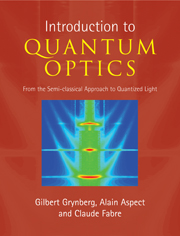Book contents
- Frontmatter
- Contents
- Foreword
- Preface
- Acknowledgements
- Part I Semi-classical description of matterlight interaction
- 1 The evolution of interacting quantum systems
- Complement 1A: A continuum of variable width
- Complement 1B: Transition induced by a random broadband perturbation
- 2 The semi-classical approach: atoms interacting with a classical electromagnetic field
- Complement 2A: Classical model of the atom-field interaction: the Lorentz model
- Complement 2B: Selection rules for electric dipole transitions. Applications to resonance fluorescence and optical pumping
- Complement 2C: The density matrix and the optical Bloch equations
- Complement 2D: Manipulation of atomic coherences
- Complement 2E: The photoelectric effect
- 3 Principles of lasers
- Complement 3A: The resonant Fabry–Perot cavity
- Complement 3B: The transverse modes of a laser: Gaussian beams
- Complement 3C: Laser light and incoherent light: energy density and number of photons per mode
- Complement 3D: The spectral width of a laser: the Schawlow–Townes limit
- Complement 3E: The laser as energy source
- Complement 3F: The laser as source of coherent light
- Complement 3G: Nonlinear spectroscopy
- Part II Quantum description of light and its interaction with matter
- Part III Applying both approaches
- Index
Complement 3D: The spectral width of a laser: the Schawlow–Townes limit
Published online by Cambridge University Press: 05 August 2012
- Frontmatter
- Contents
- Foreword
- Preface
- Acknowledgements
- Part I Semi-classical description of matterlight interaction
- 1 The evolution of interacting quantum systems
- Complement 1A: A continuum of variable width
- Complement 1B: Transition induced by a random broadband perturbation
- 2 The semi-classical approach: atoms interacting with a classical electromagnetic field
- Complement 2A: Classical model of the atom-field interaction: the Lorentz model
- Complement 2B: Selection rules for electric dipole transitions. Applications to resonance fluorescence and optical pumping
- Complement 2C: The density matrix and the optical Bloch equations
- Complement 2D: Manipulation of atomic coherences
- Complement 2E: The photoelectric effect
- 3 Principles of lasers
- Complement 3A: The resonant Fabry–Perot cavity
- Complement 3B: The transverse modes of a laser: Gaussian beams
- Complement 3C: Laser light and incoherent light: energy density and number of photons per mode
- Complement 3D: The spectral width of a laser: the Schawlow–Townes limit
- Complement 3E: The laser as energy source
- Complement 3F: The laser as source of coherent light
- Complement 3G: Nonlinear spectroscopy
- Part II Quantum description of light and its interaction with matter
- Part III Applying both approaches
- Index
Summary
The spectral width of the output of most single-mode lasers is determined by technical limitations associated with the stability of the optical length of the laser cavity (see Section 3.3.3). However, in the absence of these, there is a more fundamental limit to the degree of monochromaticity that can be achieved. This limit, known as the Schawlow–Townes limit is, in fact, rather narrower than the passive bandwidth of the laser cavity or the width of the gain curve of the active medium it contains. We calculate in a heuristic fashion in this complement the Schawlow–Townes limit for a laser operating far above threshold.
The fundamental mechanism for the spectral broadening of a laser output beam is the spontaneous emission by the gain medium of photons into the laser mode. Spontaneous emission adds to the complex field of the laser mode εL a fluctuating field, εsp corresponding to the addition of a single photon with a random phase. The total field therefore undergoes amplitude and phase fluctuations. The fluctuations of the amplitude are damped by the gain saturation of the amplifying medium and only the phase fluctuations persist, because the mechanism responsible for laser oscillation does not impose any phase to the generated field. Thus, in the course of successive spontaneous emission events, the phase of the laser field undergoes a random walk. After a time τc (the field correlation time) the phase of the laser field can no longer be predicted; it has lost all memory of its initial value.
- Type
- Chapter
- Information
- Introduction to Quantum OpticsFrom the Semi-classical Approach to Quantized Light, pp. 257 - 260Publisher: Cambridge University PressPrint publication year: 2010



